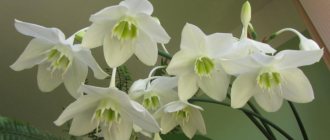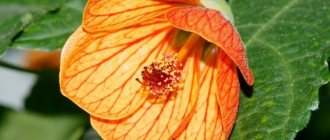Lipstick or mimulus is a spectacularly flowering herbaceous plant for open ground, which migrated to European gardens from America and the Australian continent. Red, yellow, purple, spotted and plain - the combinations of colors and shades of this bright summer tree defy description. In its homeland in America, it is called the “monkey flower” for the distant resemblance of the open bud to the face of a monkey and the consonance of the name Mimulus with the word mimo, which means monkey in Latin. In Russia, the flower is better known as gubastik, and the analogy becomes clear if you look at its photo. Those who are faced with choosing new summer plants for their flower garden should definitely pay attention to this plant for open ground - it will make the area brighter, more unusual and more cheerful.
General description with photo
The lipstick belongs to the Norichnikov family and is of Australian-American origin. Shoots rarely rise above 60 cm and, depending on the variety, can be either erect or ampelous or creeping. They may also differ in pubescence - some species have bare branches. The leaves are opposite and ovoid in shape.
Flowering occurs early, at the end of spring, gradually the flowers move to the top of the growing shoots and become noticeably smaller. If radical pruning is done at this stage of flowering, then very soon the plant will gain strength again and bloom more beautifully than before. If pruning is not done, the flower will go dormant in the summer.
The size of the inflorescences does not exceed 5 cm, but their small size is fully compensated by their interesting shape and variety of colors. The five petals are of different sizes - the upper two are smaller and slightly curved back, and the lower ones are larger and pushed forward, reminiscent of bright, capricious lips. The color palette is very diverse. After flowering ends, a fruit capsule with a large number of small, literally dust-like seeds ripens in place of the buds.
Types of mimulus
In gardening, only the most decorative and spectacular types of mimulus are cultivated. Each of them is good in its own way and has unique highlights. It is most convenient to classify them by the shade of the flowers.
Orange mimulus
A tall, heat-loving variety up to 1 m high with dark glossy leaves. The main shades are orange and pink, and the diameter of the flowers reaches 4 cm. The tall mimulus needs support because the shoots will begin to creep.
Photo: etsy.com
Speckled mimulus
An original decorative variety with red spots on top of yellow petals. It has tall and branched straight shoots that stretch up to 80 cm. There are variegated varieties.
Photo: pinterest.com
Garnet mimulus
Californian and Mexican species with complex iridescent color of buds. It effectively intertwines all shades of orange, red and burgundy.
Photo: fruitree.ru
Copper red mimulus
The beautiful variegated species combines all shades of yellow, red and red in one flower. This is one of the smallest mimulus, because its height is no more than 12-15 cm.
Photo: planteset.com
Gaping Mimulus
The spectacular lavender appearance is also called open due to the characteristic shape of the buds. There are many varieties of different sizes - from 20 cm to 1 m, and they are all very branchy.
Photo: uz.crushingplants.info
Yellow mimulus
An ancient and very popular Chilean species has spread throughout the world. It is grown in cultivation as an annual and is loved for its large yellow buds and jagged leaf blades.
Photo: it.wikipedia.org
Red mimulus
It is also called purple, and in our latitudes it grows only as an annual. These are compact bushes 40-60 cm in height with fragrant tubular red flowers.
Photo: uz.crushingplants.info
Musk mimulus
It is distinguished by a sharp, expressive aroma and fleecy short shoots up to 30 cm. The leaves are small and oval, and the canary-colored flowers reach 2.5 cm in diameter.
Photo: dachnaya-zhizn.ru
Lobularia (50 photos): types, care and planting in open ground
For home and garden
You can grow gubastik not only as a herbaceous plant for open ground, but also at home. If you combine garden cultivation of mimulus with home wintering, the plant can be cultivated as a perennial (not all varieties). In this case, it is best to take it out into the garden in a container that can be easily stored indoors for the winter. But in this case, watering it in the garden should be more frequent and regular.
For home wintering, you should completely cut off the above-ground part and find a place on a bright but cold windowsill.
Transplantation and propagation
Any type of mimulus can reproduce by self-seeding. To quickly obtain an adult bush, many gardeners prefer to propagate flowers by cuttings. In the summer, after flowering, the cuttings are cut, transplanted into a pot with loose sandy soil, and covered with a bag for better rooting. After 2 - 3 weeks, cuttings take root quite quickly. Planting of vegetatively grown sponge is done as soon as the cuttings have roots. A less common method of propagation is dividing the bush. It is used in the spring before flowering begins.
Transplanting seedlings into open ground or returning an overwintered plant back to the flowerbed is carried out only by transshipment, in order to preserve the root system. In case of damage and loss of part of the roots, the plant will bloom weakly and will devote all its energy to restoring the underground part.
Growing from seeds
In the spring, in mid-April, seeds are planted immediately in open ground. The soil, enriched with fertilizer and sand, is moistened, and the seeds are applied to the ground in an even layer. Cover the bed with a glass cap or transparent covering material for 2.5 weeks, the first shoots are thinned out, forming future flower beds. This method is less effective compared to seedlings.
Varieties of sponge with photos
The Mimolus genus is numerous and includes more than one and a half hundred species (according to other sources, 120), among which you can find both perennial varieties and annuals. In Russia, hybrid variety series based on two parent species - tiger and speckled lipweed - are most often sold and planted. But on sale you can also find individual varieties for planting in open ground and in hanging baskets.
Lipstick red (purple)
A low-growing variety, no more than 15 cm high, blooming with copper-red buds.
Lipstick yellow (orange)
The most suitable species for growing as a plant for ponds, feels great on the shore near the water. Prone to self-seeding. This is a tall species (60cm) with straight branched shoots. If the stems are not tied to supports, they gradually lie down and spread along the ground. The species is also considered most suitable for growing in hanging pots. Tolerant of short-term soil drying.
For varieties with variegated colors of mimulus, the name usually indicates the main background color, and not the palette of colored spots on the petals.
Spotted lipstick (mimulus)
Another variety to grow as a pond plant. It can grow not only on the shore itself, but also in shallow water, right in the water. The height of the stems can reach 60 cm. The flower petals are yellow and covered with contrasting dark red spots.
Opened lipstick
It begins to bloom later than other varieties, in the summer. It stretches up to half a meter or more in length. The flowers are pale lilac.
Mimulus primrose
A miniature species with short, up to 15 cm, highly branched stems. Can be grown as a living ground cover. Being a perennial, it is available for growing in containers with indoor overwintering. Blooms for a long time in a light yellow palette.
Tiger lipstick
It is also called hybrid, meaning numerous artificially bred forms through interspecific crossing, a characteristic feature of which is the resulting spotted color of the petals. Let us note the most interesting and purchased by Russian flower growers.
- "Feuerkönig" has a yellowish throat and red petals with different-sized brown spots.
- "Gatey" has a yellow throat and light pink petals with carmine-colored streaks.
- “Sun in the shade” - yellow-burgundy or white-burgundy variegated flowers.
- "Queen's Prize" - Similar to the previous honeycomb with a pronounced yellow throat and a large burgundy spot on the lower large petal.
- “Magic Mixed” - single-color or two-color flowers in pastel colors.
The varietal lines “Andean Nymph” of Chilean origin and “Highland Hybrids”, which sometimes include very different hybrids of the most exquisite forms, are distinguished by very diverse colors.
The English one is recognized as the international leader in the creation of new breeding forms of mimulus, focusing on the development of three variety lines - “Viva”, “Calypso” and the already mentioned and most famous “Majestic”. These zoned hybrids can be grown in a variety of conditions. They bloom steadily both on the rocky soil of an alpine hill and at the very edge of a decorative pond, withstand significant drops in spring temperatures and open the first buds already 1.5 months after planting. To the delight of Russian flower growers, these varietal lines in one and a half dozen color variations have already appeared on the domestic flower and seed market.
Planting mimulus in the garden
When to plant
At the beginning of May, you can begin hardening procedures, which in two weeks should gradually prepare the plants for life in the open air. Gubastik seedlings are planted in open ground in mid-May, when the threat of return frosts has passed. The sponge grows well both in open sunny areas and in partial shade. The plant prefers loamy, humus soil with the addition of peat, that is, slightly acidic. Before planting, the area is dug up, leveled and watered. Seedlings in cups also need to be well moistened.
How to plant
For seedlings, dig holes of such depth that the root system of seedlings with a ball of earth can fit in them. The distance between the holes is 20-30 cm. Planting is carried out using the transshipment method.
By the way, if you live in an area with warm springs, you can sow gubastik in the second half of April directly into open ground, provided that the average daytime temperature remains at 15-18 ºC. After sowing, the seeds are not buried in the soil, but covered with a transparent film, which is not removed until seedlings begin to appear. When the seedlings grow and become stronger, they are thinned out.
- Video about growing helenium
Possible confusion in names
Many plant varieties are bred and prepared with seeds for sale in foreign breeding nurseries, from where they are purchased in bulk by Russian companies. When they are packaged in packages, foreign names are translated into Russian in different ways, and are often simply ignored and replaced with new ones invented independently. In this regard, it is quite possible to buy the same varieties under different names from different Russian producers. Unfortunately, we have to make the analogy ourselves. To avoid such cases, it is recommended to buy different varieties of gubastik, and many other seeds grown abroad, from the same company to minimize such confusion.
Application in landscape design
Mimulus is best suited for creating small flower beds, ridges, borders, and decorating rock gardens. It gained the greatest popularity as a container flower in hanging window boxes and flowerpots.
Aquatic plants for the pond shore
Varieties of red, copper-red and speckled sponge are actively used to decorate shallow waters of ponds and reservoirs. Memulus open and yellow looks great as a coastal plant.
Growing sponge from seeds
The difficulty of seed propagation lies in the extreme fineness of the almost dusty seed material. Just one gram of it contains up to 7000 grains! For this reason, there is no need to talk about their uniform distribution over the surface of the substrate, and overconsumption is inevitable.
Sowing is done in the first half of spring on moist and slightly compacted soil. It is not necessary to sprinkle the seeds, but it is advisable to cover the top with glass or film to maintain humidity and the general microclimate. At the stage of the second pair of true leaves, it is necessary to thin out the crop, combining the procedure with picking. High temperatures are not required for seed germination; under normal room conditions, germination can be expected after 2 weeks.
Watering should be done with a spray bottle, since the seedlings are very delicate and fragile. Their development occurs quickly, by May they will become so strong that they can easily tolerate being transferred to open ground, and by the end of the month they will already bloom.
Mimulus seeds remain viable for at least 3-4 years.
Planting and caring for mimulus
- Flowering: twice per season.
- Planting: sowing seeds for seedlings - at the end of March or early April, planting seedlings in open ground - in mid-May.
- Lighting: bright sunlight or partial shade.
- Soil: slightly acidic humus loams, that is, with the addition of peat.
- Watering: frequent, especially in hot weather: the soil on the site should be slightly moist at all times.
- Feeding: once a month with a solution of 15 g of complex mineral fertilizer.
- Pruning: After the first flowering, which lasts several weeks, the shoots of the plant are pruned. The second flowering occurs on newly grown shoots.
- Reproduction: seed.
- Pests: aphids, whiteflies, slugs.
- Diseases: black leg, powdery mildew, gray rot.
Read more about growing mimulus below.
Trimming
In principle, pruning is not a mandatory part of the “monkey flower” agricultural technology. But, if you leave the shoots to grow uncontrollably, the flowering will gradually move to their top, the buds will become smaller and the overall appearance of the flowerbed will lose its decorative effect, becoming untidy and careless. Pruning shoots at this stage almost to the root is a well-known technique for stimulating the re-blooming of annuals. A new wave of flowering may come very soon, so there is no need to feel sorry for the plant, especially since the tops can be additionally rooted using the cutting principle if desired.
To make the plant bush better, it is recommended to periodically pinch the tops of the shoots.
Sowing seeds for seedlings
You can buy sponge seedlings at gardening stores or grow them yourself. If you want to grow mimulus seedlings from seeds, you need to follow the instructions below.
- You can collect planting material after the flower blooms, when the fruit boxes are fully ripe. Seeds can also be purchased at the store.
- Seeds should be planted no later than the first half of April, but some varieties with an early flowering period can be sown as early as the end of February.
- To plant mimulus seeds at home, it is better to choose nutritious, neutral or slightly acidic soil (up to 5.8 acidity level). A universal soil for garden plants is also suitable here, but you will need to add humus, peat and sand to it. Ideally, the substrate for planting gubastica seeds should include turf, leaf soil, peat, sand and humus in a ratio of 1: 2: 1: 1: 3.
- For planting seeds, it is best to use wooden or polymer boxes, but be sure to have holes for moisture drainage. Small plastic cups or ceramic pots also work well here.
- First, high-quality drainage from gravel or broken brick is placed in containers, then soil is carefully placed, which is loosened and wetted with a sprayer.
- The seeds of the sponge are very small, so you need to handle them with a toothpick. Try to distribute the planting material evenly throughout the container, maintaining a distance of at least 2-3 cm between the seeds. There is no need to deepen the seeds, just press them down a little.
Further seed care also includes a number of specific activities.
After planting the seeds, the soil in the containers is sprayed again with a spray bottle, then the containers are placed in a warm place (with a temperature of at least 18 degrees) and covered with film or glass. It is very important to control the frequency of watering and not allow the soil to dry out or become waterlogged. In some cases, mold appears under the film on the ground - this is a sign that the container needs to be ventilated occasionally. As soon as the first sprouts of sponge appear, the seedlings are placed in a cooler room with good lighting
Ideally, the temperature should not drop below 10 degrees, humidity should not exceed 80%. If there is not enough lighting in the room or it is regularly a cloudy day outside, special lamps are installed above the seedlings. Approximately 7-8 days after the sprouts appear, the soil in the containers is fertilized with a complex fertilizer containing nitrogen and potassium. The following feedings are carried out at intervals of 10-12 days. As soon as the sprouts have 3 healthy petals, they are transplanted into separate containers - peat pots or paper cups with a volume of at least 150 ml are best suited here. Up to 3-4 seedlings can be placed in each container.
Choosing a landing site
The sponge is light-loving, but not so much that it needs to grow in an open place; it is better to provide it with light temporary shading during the day. But with the humidity of the growing area, everything is not so clear. The speckled sponge can tolerate temporary waterlogging, but if it is left to overwinter, it prefers a dry overwintering. Only the open-faced lipstick can live “in knee-deep water” all the time. In this case, it is better to plant it not in the ground, but in a container, which is immersed in water.
general information
Mimulus is a wonderful decoration for flower beds and rock gardens. It can be grown in containers, flowerpots, or anything else you like. Herbaceous species grow up to 70 cm, and shrubby ones - up to 150. Shoots can be straight or creeping, but always branched.
The most interesting feature of mimulus is its unusual shape of buds, for which the plant is nicknamed gubastik. The flowers are asymmetrical, up to 5 cm in diameter, with a bent, segmented lip. But the name “mimulus” is associated with mimes and the plant’s ability to mimic – change shade.
Photo: oir.mobi
Diseases and pests
If the soil is constantly waterlogged, the sponge can be affected by slugs and snails. You will have to collect the pests by hand, then loosen the bed well and wait until the top layer of soil dries. After this, sawdust mulch is added and the watering regime is adjusted.
The most likely diseases are blackleg (especially at the stage of young seedlings) and powdery mildew. Overmoistening can also be a provoking factor, if we are not talking about species used for landscaping reservoirs. Diseased plants will have to be removed and destroyed, and the remaining ones will have to be treated with systemic fungicides.
How to properly care?
The spongy plant, regardless of its variety and variety, can hardly be called a fastidious plant. In general, all care for this flower comes down to regular watering and feeding - these procedures directly affect the abundance and richness of the color of mimulus buds.
Watering
Regular watering and a consistently high level of humidity are the key to a beautiful, strong and healthy mimulus. Ideally, this plant should be watered daily, especially during the summer season. Keep in mind that the tree trunk circle near the plant should always be slightly moistened - for this, a layer of mulch is usually organized near the sponge. Despite the fact that mimulus loves moisture very much, you should not overdo it with the amount of water for 1 watering. Excessive moisture can lead to rotting of the roots, the formation of fungus on the bush, as well as the appearance of snails and slugs - the main pests of this flower.
To water mimulus, lukewarm but settled water should be used. Watering itself is done in the morning or evening. From the sun's rays, the moisture in the root circle near the flower will quickly dry out and can burn its leaves. The lack of moisture in the roots of the plant will be indicated by the general sluggish appearance of the bush and the lack of flowering; an excess amount of moisture can be guessed by small holes on the leaf blades.
Top dressing
Regular feeding is mandatory to strengthen the immunity of the sponge and the richness of the color of its buds. Typically, mineral fertilizers with potassium, phosphorus and nitrogen are chosen for these plants. The very first fertilizing is carried out 3 weeks after planting a young plant in open ground. After this, fertilizing should be done at least once a month.
Typically, a solution of 15 ml of a mineral preparation and 10 liters of water is used to feed mimulus. You should not overdo it with the percentage of nitrogen in fertilizers - it will lead to the formation of a large number of shoots and greenery, increase the height of the plant, but reduce the number of inflorescences. It is recommended to additionally feed the sponge during periods of active growth, after pruning, and also if the plant is sick.
Loosening and mulching
Professional gardeners recommend loosening the mimulus tree trunk after each watering - this is necessary so that the moisture is quickly absorbed into the soil and reaches the roots. In addition, loosening allows you to remove weeds that may interfere with the growth of the flower. You should not overdo it with the depth and thoroughness of loosening - the gubastik has superficial root shoots that are easy to damage. As for mulching, it is carried out not only to retain moisture near the roots of the plant, but also blocks the growth of weeds, and also provides passive fertilizing of the soil after each watering.
Depending on the type of sponge, the following materials can be used as mulch: pine needles, fallen leaves, humus, peat, straw and sawdust. The layer of mulch is selected based on the type of soil on the site - for loam it should be no more than 2-3 cm, for sandy loam soils - up to 6 cm. Try to lay the layer of mulch in such a way as not to touch the trunk of the plant.
Wintering
Some gardeners grow gubastik as a perennial, but wintering the plant outdoors is impossible - everything is explained by the warm homeland of this flower and its inability to withstand prolonged frosts. Already in the fall, after the end of the mimulus flowering period, its bush is cut short, then dug up along with a lump of earth and transplanted into a small container. It is best to store a container with a flower on a windowsill or place it on a loggia.
Benefit
This beautiful plant is often used in landscape design. Mimulus is planted along paths, grown in flowerpots, and used to create alpine slides. The flower is unpretentious; it is planted to decorate shady areas, places with high humidity, and ponds.
The decorative qualities of the plant were highly appreciated by professional designers. Mimulus will perfectly decorate an open terrace or balcony. Some varieties are grown in hanging structures, and some species are grown in water. Containers are placed on the bottom of the reservoir, flowers bloom on the surface. Mimulus can be planted separately or together with other ornamental plants. Successful combinations:
- in the flowerbed - rush grass, hosta, astilbe;
- in a flowerpot - matthiol;
- on the balcony - verbena, lobelia;
- on the alpine hill - periwinkle, buttercup, saxifrage.
Mimulus is also used in homeopathy and traditional medicine. Essences and drops with plant extract are produced abroad. Drugs are prescribed for disorders of the heart, blood vessels, and nervous system. It is believed that mimulus extract helps shy, fearful people eliminate anxiety and fear.
When and how does it bloom
Mimulus flowers have different flowering times, depending on the variety and cultivar. An additional difference is the shape and color of the buds themselves.
Blooming mimulus buds
The types of flowers can be very diverse, because each variety is completely individual. And there are more than 15 units. The shape can be spongy - 4 buds are located up, and the fifth down. Sometimes the flowers look more like lilies. Here the variety of forms is also great.
Additional Information! Typically the flowering period lasts from mid-May to the end of June. The second stage lasts from mid-August to the end of September. But some varieties bloom from May to July without stopping the formation of buds.
During the flowering period, you need to carefully monitor watering, since the active growing season requires additional irrigation. In the first and second flowering periods, fertilizing can be reduced to 1 per month. dry leaves, twigs and buds must be removed immediately.
Varieties
- 'Bee`s Scarlet' and 'Highland Orange' – bright orange flowers;
- 'Highland Pink' – intense pink color;
- 'Highland Red' – dark red;
- 'Highland Yellow' – bright yellow flowers;
- 'Hose in Hose' – slightly olive flowers with a double corolla;
- 'Inca Sunset' – orange-red flowers;
- 'Inshriach Crimson' – dark purple-red;
- 'Whitecroft Scarlet' – flowers red to reddish-orange;
- 'Wisley Red' – produces velvety blood-red flowers and grows up to 15cm tall.
Unfortunately, we only have mixtures of different varieties available. It’s worse if the varieties are of different heights and shapes. Those who have the opportunity can purchase seeds for the garden: “Magic F1” mixture – 15-20 cm tall, for containers “Maksimus F1” mixture – 30 cm tall with drooping shoots, which a little later “flow” beautifully from the pot.
Mimulus hybrid, or brindle
Mimulus hybrid , or tiger (Mimulus hybridus) , lipstick or monkey flower, belongs to the Phrymaceae family.
The genus includes approximately 60 species. Mimulus are subshrubs and short-lived perennials. Since the species grow in warmer zones, the most resistant ones can withstand frosts down to -5 ° C, cultivation in our country can only be an annual or indoor potted plant. This article will not describe specific species, since the species are more difficult to acquire and cultivation is similar. Focus is on available hybrid seeds grown as annuals.
The varieties have raised or drooping stems, the lower part is branched. The leaves growing on the stem are usually long with a serrated edge. Flowers grow from the axils of the leaves on short petioles, 3-5 cm in diameter.
When and how does it bloom
The splendor of flowering depends on proper care of the flower.
- Types of flowers. Depending on the variety, they can be plain or spotted, combining several shades.
- Flower shapes. All petals have it wrong.
- Flowering period - 2 times per season: in spring and autumn.
Mimulus has lush flowering
Changes in care during the flowering period and after
Mimulus, planting and caring for which is quite simple, requires more frequent watering during lush flowering. Fertilizing will help prolong flowering.
When mimulus fades, it goes into a period of calm, then you can slightly reduce the frequency of watering and not use fertilizers.
Immediately after the first flowering, the plant must be completely pruned. During the summer, before the next flowering, new shoots will appear again.
Important! Dried or drooping branches of a flower should be regularly trimmed so that they do not spoil the appearance of the bush.
Collecting seeds
When the fruit is ripe, it will burst into 2 parts from which the seeds can be extracted. Grains should be collected only from those flowers that are distinguished by abundant flowering and lush, dense foliage.
Preparing for winter
Before the onset of cold weather, the flower must be dug up from the garden and transplanted into a pot. A few days after transplantation, when the mimulus comes to its senses, it must be cut short. It must be kept in a warm room all winter.
Reproduction of mimulus sponge by dividing the bush
How to divide mimulus gubastik photo
Perennials can be easily divided when the bush has grown well. To do this, dig up the plant, carefully remove it from the ground along with the lump and cut it into 2-3 parts with a sharp knife. If desired, you can get more divisions, leaving at least 2-3 growth buds per bush. The resulting new seedlings are planted in pre-prepared holes, maintaining the same planting level. Water generously.
Humidity should be monitored by regularly watering the plants until they are completely rooted. However, in the future, mimuluses really like it when the soil remains moist.











